Robert Walter Weir | |
|---|---|
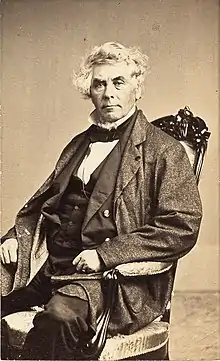 Robert Walter Weir, circa 1864 | |
| Born | June 18, 1803 New York City, New York, U.S. |
| Died | May 1, 1889 (aged 85) New York City, New York, U.S. |
| Nationality | American |
| Education | Self-taught |
| Known for | Painting |
| Movement | Realism, Hudson River School |
Robert Walter Weir (June 18, 1803 – May 1, 1889) was an American artist and educator and is considered a painter of the Hudson River School.[1] Weir was elected to the National Academy of Design in 1829 and was an instructor at the United States Military Academy. His best-known work is Embarkation of the Pilgrims in the United States Capitol rotunda in Washington, D.C.[2] More than 450 of his works are known,[3] and he created many unsigned paintings that may never be attributed to him.
Life and career
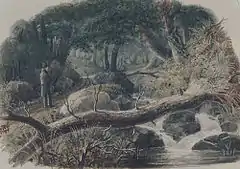
Weir was born to Robert and Mary Katherine Brinckley (or Brinkley) Weir on June 18, 1803 in New York City.[4] His father worked at mercantile and shipping jobs. His mother Mary is remembered for composing the song "The Lord of the Castle."[5] Robert never graduated from college, and he left a job as a mercantile clerk to pursue painting in 1821 at age 18. He studied art in New York City from 1822 to 1824, teaching himself drawing and painting before departing to study in Italy in 1824.[6] He remained in Florence from 1824 to 1825, then in Rome from 1825 to 1827, during which time he studied the works of Michelangelo, Raphael, and other Italian masters of the Renaissance. He returned to New York in 1827 to care for a sick friend and remained there until 1834, becoming an integral part of its artistic community. He was appointed as Teacher of Drawing (1834–1846) then Professor of Drawing (1846–1876) at the United States Military Academy at West Point, New York.[2][7]
Weir was the fifth artist to hold the position of art instructor at the academy.[8] During his 42 years (1834–1876) in this post, he instructed many of the future commanders of the American Civil War. Among his notable students at West Point were James Abbott McNeill Whistler and Seth Eastman. He also developed a special relationship with Ulysses S. Grant.[7] He died in New York City on May 1, 1889.[8]
Children
Weir was married twice and had 16 children.[9] Son John Ferguson Weir (born 1841) was a painter and sculptor who became a Member of the National Academy of Design in 1866, and was made director of the Yale University Art School in 1868. Son Julian Alden Weir (born 1852) studied under his father and under J.-L. Gérôme and became a distinguished portrait, figure, and landscape painter. He was one of the founders of the Society of American Artists in 1877, and he became a member of the National Academy of Design (1886) and of the Ten American Painters, New York.[2] Daughter Emma Weir married Thomas Lincoln Casey Sr., an American army officer and Chief of Engineers. Daughter Helen Rutgers Weir married Thomas Sturgis, a developer of Cheyenne, Wyoming, and the second New York City Fire Commissioner.[10] His granddaughter was the educator and artist Irene Weir.
Works


Weir was considered part of the Hudson River School of American art. One of his best known paintings is The Embarkation of the Pilgrims which hangs in the United States Capitol rotunda. He was commissioned by the United States Congress in 1837 and the painting was placed in the rotunda in December 1843.[11] His canvases deal principally with historical subjects, though he also did several portraits.
Works
- Paul Preaching at Athens
- Two portraits of Sylvanus Thayer [Pappus, p. 210]
- Embarkation of the Pilgrims at Delft Haven, Holland, July 22, 1620
- Picnic Along the Hudson[12]
- Saint Nicholas (1837)[13] in the collection of the Smithsonian American Art Museum[14]
- Landing of Hendrik Hudson (1842)
- Amerigo Vespucci (1842)
- A Compositor Setting Type (ca. 1844)[15]
- Portrait of Robert E. Lee. One of only two portraits of Lee painted before the Civil War.
- Microscope (1849)
- Evening of the Crucifixion (1867)
- Virgil and Dante crossing the Styx (1869)
- Seascape with Lighthouse, 1869. Exhibited at Whitney Museum, New York, 1975, in exhibition entitled "Seascape and the American Imagination"
- The Portico of the Palace of Octavia, Rome (1870)
- Net Mending on Nantucket (1870)
- Christ in the Garden (1873)
- Our Lord in the Mount of Olives (1877)
- Indian Falls (1878)
- Titan in his Studio
- Columbus before the Council of Salamanca (1884)
- The Bourbons Last March
- Indian Captive
- Taking the Veil
- The Evening of the Crucifixion
- Portrait of Jared Mansfield
- Portrait of General Winfield Scott
- Portrait of Dennis Hart Mahan
- Il Penseroso
Portraits
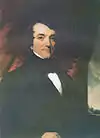
 James Monroe, (after Durand and Stuart)
James Monroe, (after Durand and Stuart)
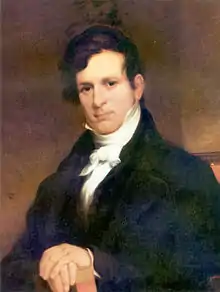
Other works
 Saint Nicholas, 1837
Saint Nicholas, 1837 The Microscope, 1849
The Microscope, 1849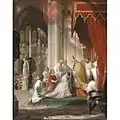 Taking the Veil, 1863
Taking the Veil, 1863 The Hudson River from Hoboken, 1878
The Hudson River from Hoboken, 1878
See also
References
- ↑ "Robert W". Math.usma.edu. 2000-11-28. Archived from the original on 2012-09-29. Retrieved 2012-05-20.
- 1 2 3 One or more of the preceding sentences incorporates text from a publication now in the public domain: Chisholm, Hugh, ed. (1911). "Weir, Robert Walter". Encyclopædia Britannica. Vol. 28 (11th ed.). Cambridge University Press. p. 496.
- ↑ "Robert Walter Weir Paintings". RobertWalterWeir.com. Retrieved 13 May 2019.
- ↑ Webber, Richard (October 1930). "Birthplace of Robert Walter Weir, Artist". New-York Historical Society Quarterly Bulletin. 14.
- ↑ Claghorn, Charles Eugene, 1911-2005. (1996). Women composers and songwriters : a concise biographical dictionary. Lanham, Md.: Scarecrow Press. ISBN 0-585-03162-2. OCLC 42329817.
{{cite book}}: CS1 maint: multiple names: authors list (link) CS1 maint: numeric names: authors list (link) - ↑ Kent Ahrens,"The Portraits of Robert Weir," American Art Journal, Vol. 6, No. 1, p. 4
- 1 2 Ahrens, p. 4.
- 1 2 "USMA site on Weir". Math.usma.edu. 2000-11-28. Archived from the original on 2012-09-29. Retrieved 2012-05-20.
- ↑ Jones, Jennifer (Spring 2012). "Portraits of Influence:Robert Walter Weir (1803-89)". BYU Magazine: 31.
- ↑ Gardner, Deborah S.; McKay, Christine G. (2009). "An Artist's Retreat: J. Alden Weir's Farm in Connecticut" (PDF). National Park Service. p. 30.
- ↑ "Architect of the Capitol page on Embarkation of the Pilgrims". Aoc.gov. Retrieved 2012-05-20.
- ↑ "Robert Weir - Artist, Fine Art, Auction Records, Prices, Biography for Robert Walter Weir". Askart.com. 2008-12-03. Retrieved 2012-05-25.
- ↑ "East Baltimore Documentary Survey Project by Joan Clark Netherwood / American Art". Americanart.si.edu. Retrieved 2012-05-25.
- ↑ Reed, Henry Hope (2005). The United States Capital: Its Architecture and Decoration. New York: W.W. Norton & Company. p. 203. ISBN 0-393-03831-9.
- ↑ Untitled, Hawk-Eye (Burlington, Iowa), 13 June 1844
External links
- Art and the empire city: New York, 1825-1861, an exhibition catalog from The Metropolitan Museum of Art (fully available online as PDF), which contains material on Robert Walter Weir (see index)
- Catalogue of oil paintings and water colors by Robert W. Weir, an auction catalog from The Metropolitan Museum of Art (fully available online as PDF)
- Catalogue of oil paintings and water colors by Robert W. Weir, at archive.org, as the MMA one disappeared
- New York Times article retrieved December 14, 2007
- Artwork by Robert Walter Weir
- Askart.com, io information retrieved December 14, 2007
- Finding aid authors: Dennis Rowley and Loretta Trentman (2014). "Weir family papers". Prepared for the L. Tom Perry Special Collections, Provo, UT. Retrieved May 16, 2016.